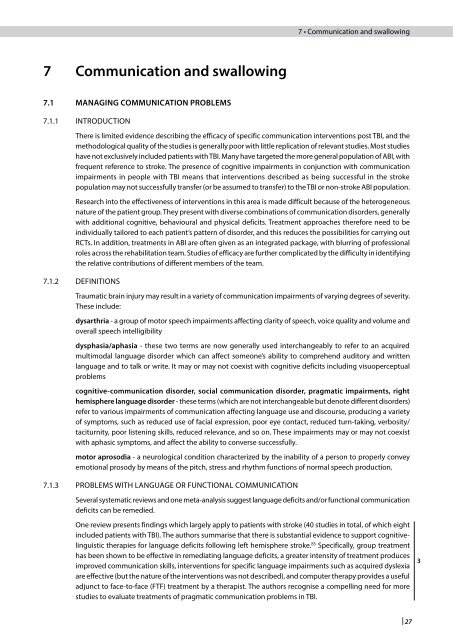sign130
sign130
sign130
Create successful ePaper yourself
Turn your PDF publications into a flip-book with our unique Google optimized e-Paper software.
7 Communication and swallowing<br />
7.1 MANAGING CoMMuNICATIoN PRoBlEMS<br />
7.1.1 INTRODUCTION<br />
There is limited evidence describing the efficacy of specific communication interventions post TBI, and the<br />
methodological quality of the studies is generally poor with little replication of relevant studies. Most studies<br />
have not exclusively included patients with TBI. Many have targeted the more general population of ABI, with<br />
frequent reference to stroke. The presence of cognitive impairments in conjunction with communication<br />
impairments in people with TBI means that interventions described as being successful in the stroke<br />
population may not successfully transfer (or be assumed to transfer) to the TBI or non-stroke ABI population.<br />
Research into the effectiveness of interventions in this area is made difficult because of the heterogeneous<br />
nature of the patient group. They present with diverse combinations of communication disorders, generally<br />
with additional cognitive, behavioural and physical deficits. Treatment approaches therefore need to be<br />
individually tailored to each patient’s pattern of disorder, and this reduces the possibilities for carrying out<br />
RCTs. In addition, treatments in ABI are often given as an integrated package, with blurring of professional<br />
roles across the rehabilitation team. Studies of efficacy are further complicated by the difficulty in identifying<br />
the relative contributions of different members of the team.<br />
7.1.2 DEFINITIONS<br />
Traumatic brain injury may result in a variety of communication impairments of varying degrees of severity.<br />
These include:<br />
dysarthria - a group of motor speech impairments affecting clarity of speech, voice quality and volume and<br />
overall speech intelligibility<br />
dysphasia/aphasia - these two terms are now generally used interchangeably to refer to an acquired<br />
multimodal language disorder which can affect someone’s ability to comprehend auditory and written<br />
language and to talk or write. It may or may not coexist with cognitive deficits including visuoperceptual<br />
problems<br />
cognitive-communication disorder, social communication disorder, pragmatic impairments, right<br />
hemisphere language disorder - these terms (which are not interchangeable but denote different disorders)<br />
refer to various impairments of communication affecting language use and discourse, producing a variety<br />
of symptoms, such as reduced use of facial expression, poor eye contact, reduced turn-taking, verbosity/<br />
taciturnity, poor listening skills, reduced relevance, and so on. These impairments may or may not coexist<br />
with aphasic symptoms, and affect the ability to converse successfully.<br />
motor aprosodia - a neurological condition characterized by the inability of a person to properly convey<br />
emotional prosody by means of the pitch, stress and rhythm functions of normal speech production.<br />
7.1.3 PROBLEMS WITH LANGUAGE OR FUNCTIONAL COMMUNICATION<br />
7 • Communication and swallowing<br />
Several systematic reviews and one meta-analysis suggest language deficits and/or functional communication<br />
deficits can be remedied.<br />
One review presents findings which largely apply to patients with stroke (40 studies in total, of which eight<br />
included patients with TBI). The authors summarise that there is substantial evidence to support cognitivelinguistic<br />
therapies for language deficits following left hemisphere stroke. 85 Specifically, group treatment<br />
has been shown to be effective in remediating language deficits, a greater intensity of treatment produces<br />
improved communication skills, interventions for specific language impairments such as acquired dyslexia<br />
are effective (but the nature of the interventions was not described), and computer therapy provides a useful<br />
adjunct to face-to-face (FTF) treatment by a therapist. The authors recognise a compelling need for more<br />
studies to evaluate treatments of pragmatic communication problems in TBI.<br />
| 27<br />
3


